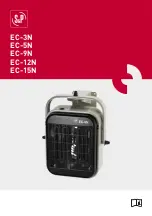
1.
Do not attempt to install, repair, or service this heater
or the gas supply line unless you have continuing
expert training and knowledge of gas heaters.
Qualifications for service and installation of this
equipment are as follows:
a. To be a qualified gas heater service person, you
must have sufficient training and experience to
handle all aspects of gas-fired heater installation,
service and repair. This includes the task of
installation, troubleshooting, replacement of
defective parts and testing of the heater. You must
be able to place the heater into a continuing safe
a n d n o r m a l o p e r a t i n g c o n d i t i o n . Yo u m u s t
completely familiarize yourself with each model
heater by reading and complying with the safety
instructions, labels, Owner’s Manual, etc., that is
provided with each heater.
b. To be a qualified gas installation person, you must
have sufficient training and experience to handle
all aspects of installing, repairing and altering gas
lines, including selecting and installing the proper
equipment, and selecting proper pipe and tank size
to be used. This must be done in accordance with
all local, state and national codes as well as the
manufacturer’s requirements.
c.
In the Commonwealth of Massachusetts, this
product must be installed by a gas fitter licensed
by the Commonwealth of Massachusetts.
2.
All installations and applications of L.B. White heaters
must meet all relevant local, state and national codes.
Included are L.P. gas, natural gas, electrical, and
safety codes. Your local fuel gas supplier, a local
licensed electrician, the local fire department or
similar government agencies, or your insurance agent
can help you determine code requirements.
Also refer to:
-- ANSI/NFPA 58, latest edition, Standard for
Storage and Handling of Liquefied Petroleum
Gas
-- ANSI Z223.1/NFPA 54, National Fuel Gas Code
-- CAN/CSA B149.1 Natural Gas and Propane
Installation Code
3.
The heater shall not be directed toward any propane
gas container within 20 ft. (6 m).
4.
Disconnect the heater from its propane gas supply
container when relocating.
5.
Do not move the heater while it is in operation.
6.
We cannot anticipate every use which may be made of
our heater. Check with your local fire safety authority
if you have questions about applications.
7.
Other standards govern the use of fuel gases and heat
producing products in specific applications. Your local
authority can advise you about these.
8
Use only compressed air, a soft brush, or dry cloth to
clean the heater and it’s components. Allow the heater
to completely cool before cleaning or servicing.
9.
Always use approved pipe thread compound suitable
fo r u s e w i t h p ro p a n e g a s o n t h e t h r e a d e d
connections.
10.
Do not block air intakes or discharge outlets of the
heater. Doing so may cause improper combustion or
damage to heater components leading to property
damage.
11.
The hose assembly shall be visually inspected before
each use of the heater. If it is evident there is
excessive abrasion or wear, or if the hose is cut, it
must be replaced prior to the heater being put into
operation. The hose assembly shall be protected
building materials, and contact with hot surfaces
during use. The hose assembly shall be that specified
by the manufacturer. See parts list.
12.
Check for gas leaks and proper function upon heater
installation or when relocating. Refer to leak check
instructions within installation section of this manual.
13.
This heater should be inspected for proper operation
by a qualified service person before each use and at
least annually.
14
Always turn off the gas supply to the heater if the
heater is not going to be used.
15.
If gas flow is interrupted and flame goes out, do not
relight the heater until you are sure that all gas that
may have accumulated has cleaned away. In any
event, do not relight the heater for at least 5 minutes.
16.
Minimum propane gas supply cylinder size to be used
shall be 100 pounds (45 kg). When using a cylinder
supply system, the system must be arranged to
provide vapor withdrawal from the operating cylinder.
17
W h e n t h e h e a te r i s to b e s to r e d i n d o o r s , t h e
c o n n e c t i o n b e t we e n t h e p ro p a n e g a s s u p p l y
cylinder(s) and the heater must be disconnected and
the cylinder(s) removed from the heater and stored in
accordance with the Standard and Handling of
Liquefied Petroleum Gases, ANSI/NFPA 58, or the
Natural Gas and Propane Installation Code, CAN/CSA
B149.1 as appropriate .
18.
Propane gas supply containers have left handed
threads. Always use the appropriate wrench to tighten
or loosen the regulator’s P.O.L. fitting at the propane
gas container’s supply valve.
6
WARNING
Burn Hazard
■
Radiant heaters are normally quiet during operation.
■
Always be aware of your proximity to the radiant
heater during its use.
■
D o n ot to u c h t h e h e a te r o r c o m e w i t h i n s a fe
clearances given on dataplate and Owner’s Manual.
■
Failure to follow this warning can result in ignition of
clothing and burns, causing severe injury.







































